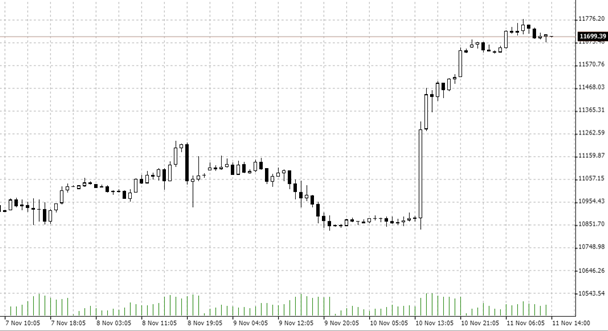

11.11.2022 – It can happen that fast: A less than feared horrendous inflation report pushes up prices on Wall Street. The Federal Reserve also adds fuel to the fire. What a coincidence… And already one stop-loss mark of the bears falls after the other. The question is: How sustainable is the short squeeze?
The high-tech Nasdaq stock market just had its third best day since October 2008 from the perspective of long traders. Here is the hourly chart of the Nasdaq 100.

Source: Bernstein Bank GmbH
The catalyst for this: the Consumer Price Index (CPI) for October came in at 7.7 percent, slightly below the expectations of most analysts, who had predicted 8.0 percent on the whole. After all, this was the lowest inflation since January. Ergo, many investors assumed that the Federal Reserve would now put the brakes on tightening. And indeed, some doves immediately spoke up: a whole handful of Fed officials drove prices higher.
The Fed encourages the bulls
For example, Kansas City Federal Reserve President Esther George judged that the central bank could now take a more measured approach to assessing the economy. However, she added, a continued path in rate hikes is appropriate.
Patrick Harker, head of the Federal Reserve Bank of Philadelphia, said the Fed could slow the pace of rate hikes in the coming months. And in the coming year, he said, the Fed might even tighten. He favored a pause in rate hikes at a rate of 4.5 percent.
Federal Reserve Bank of Cleveland President Loretta Mester added, however, that the biggest risk in inflation is that the Fed doesn’t raise rates enough. While the October CPI is showing signs of easing, the Fed should continue to raise rates to contain inflation.
Hit the brakes
Lorie Logan, head of the Federal Reserve Bank of Dallas, explained the CPI is a welcome easing – but there is still a long way to go. However, she added, it may be appropriate to slow the pace of rate hikes to reassess the situation.
Mary Daly, head of the San Francisco Federal Reserve, called the CPI “good news.” However, she said, one month of positive data is not enough to declare a definitive victory. In addition, service inflation continued to rise. However, the time has come to slow the pace of rate hikes, he said.
The Dallas Fed’s Lorie Logan also signaled a step on the brakes in a cloistered way: “While I believe it may soon be appropriate to slow the pace of rate increases so we can better assess how financial and economic conditions are evolving, I also believe a slower pace should not be taken to represent easier policy.”
The Wall Street Journal commented, “The October inflation report is likely to keep the Fed on track to approve a (50bps rate hike) next month.” It said the Fed has already signaled a slower pace. The paper is considered the unofficial mouthpiece of the Fed.
Fodder for the bulls
Our conclusion: the bull run may indeed not be over yet. For it is a strange coincidence that almost at the same time as the CPI, several grandees of the Federal Reserve are pushing themselves into the foreground with predominantly dovish word messages. This looks very much like a signal from the monetary guardians that the interest rate screw is not being tightened as much as feared. And that the cycle of rate hikes will soon be over. Bernstein Bank is keeping an eye on the matter for you!
__________________________________________________________________________________________
The content of this publication is for general information purposes only. In this context, it is neither an individual investment recommendation or advice nor an offer to purchase or sell securities or other financial products. The content in question and all the information contained therein do not in any way replace individual investor- or investment-oriented advice. No reliable forecast or indication for the future is possible with respect to any presentation or information on the present or past performance of the relevant underlying assets. All information and data presented in this publication are based on reliable sources. However, Bernstein Bank does not guarantee that the information and data contained in this publication is up-to-date, correct and complete. Securities traded on the financial markets are subject to price fluctuations. A contract for difference (CFD) is also a financial instrument with leverage effect. Against this backdrop, CFD trading involves a high risk up to the point of total loss and may not be suitable for all investors. Therefore, make sure that you have fully understood all the correlating risks. If necessary, ask for independent advice. CFDs are complex instruments and are associated with the high risk of losing money quickly because of the leverage effect. 68% of retail investor accounts lose money trading CFD with this provider. You should consider whether you understand how CFD work and whether you can afford to take the high risk of losing your money.7
